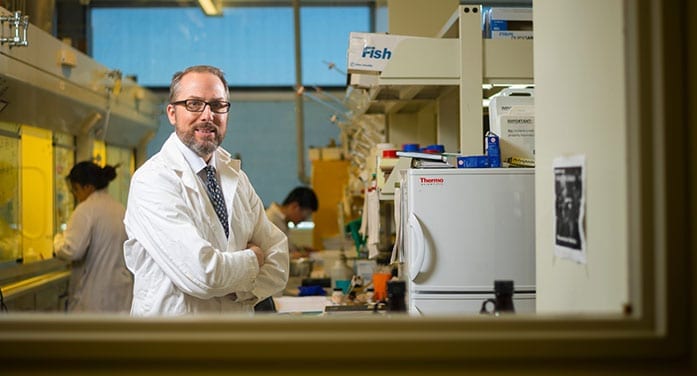When Russian chemist Dmitri Mendeleev published the periodic table of the elements in 1869, he invented not only a roadmap for access to all known and future compounds, but also the “chemist’s playground.”
“It’s our playbook,” said the University of Alberta’s Dennis Hall, a professor in the Faculty of Science and Canada Research Chair in Boron Chemistry for Catalysis and Drug Discovery. “It has the building blocks that we use to make all new molecules, compounds and materials.
“But you can only go so far as your ability to characterize compounds.”

U of A chemistry professor Dennis Hall says infrastructure upgrades made possible by new funding, along with existing technology in other labs, will make the university a leader in materials characterization—an essential step in finding potential applications for newly created molecules, compounds and materials. (Photo: John Ulan)
To capture desirable or improved properties, Hall said researchers need to innovate by exploiting a larger sweep of the periodic table – integrating elements that are currently neglected or unconventional.
“Every chemist pushes to make new stuff, but you need to be able to characterize it. You need to be able to find out exactly what you have crafted,” he explained.
To help U of A researchers take that next step in characterizing compounds, the federal government, through the Canada Foundation for Innovation, is investing $5.1 million in a characterization equipment upgrade worth $12.7 million.
“It will really elevate the infrastructure that we have right now for characterization of compounds of all sorts,” said Hall, who applied for the funding along with his Department of Chemistry colleague Vladimir Michaelis.
The key new instrument is the high field solid-state NMR (nuclear magnetic resonance) instrument.
“It’s going to make us a leader in materials characterization, especially when you couple this to the instruments we already have with nanoFAB on campus, and other facilities including the DNP (dynamic nuclear polarization) lab,” said Hall.
The U of A will also gain new mass spectrometry and higher-resolution X-ray crystallographic instruments that will allow researchers to essentially “take a photo of a molecule.”
Once compounds can be characterized, Hall said, the applications are endless.
For instance, one research team will immediately start work on the next phase of battery storage, the sodium battery.
“The lithium battery is used in everything, cellphones, electric cars – they’re very small and very convenient, but the environmental cost is pretty expensive,” he said of the mining process involved. “The problem is to develop the electrochemistry that would be as efficient with sodium as it is currently with lithium – so we’re talking about performance.”
Another project will see chemistry professors Jillian Buriak and Jonathan Veinot investigate new materials to enhance solar energy, while Sasha Wilson in the Department of Earth and Atmospheric Sciences will use the infrastructure to look at the composition of minerals in a way to make mining cleaner.
Hall will continue his research into the unconventional use of boron in creating pharmaceuticals. He said the metalloid is a relatively non-toxic element that so far has shown promise toward anti-infective drugs.
“Something I’m very proud of is the team that I’ve assembled for that project. There are 10 principal investigators who are at the top of their fields and already have a record of commercializing discoveries,” said Hall.
“What we really need to be competitive globally is to get good or better characterization instruments than our competitors.
“This will do that.”
| By Michael Brown for Troy Media
This article was submitted by the University of Alberta’s Folio online magazine. Folio is a Troy Media![]() Editorial Content Provider Partner.
Editorial Content Provider Partner.


